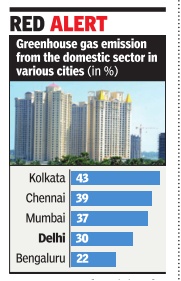Greenhouse gases: India
This is a collection of articles archived for the excellence of their content. |
2014: The sectors responsible
Mar 23 2015
Vinayashree Jagadeesh
Urban homes emit more greenhouse gases than industry
The industrial sector has been taking the flak for emitting high levels of hazardous gases over the years but it might ultimately be our homes that are responsible for the highest emission of greenhouse gases. A study by the Centre for Ecological Sciences of the Indian Institute of Science, Bengaluru, found that the domestic sector in seven cities was one of the highest contributers to greenhouse gases, which are responsible for global warming.
When the cities were considered individually , the domestic sector was the highest contributor in Chennai, Ahmedabad, Kolkata and Mumbai, and second highest contributor in Delhi, Hyderabad and Bengaluru.
Major sources of energy consumption in the domestic sector were electricity for lighting and household appliances and fuel for cooking.The fuels considered during the study were liquefied petroleum gas, piped natural gas and kerosene. Delhi's domestic con sumption accounted for the highest greenhouse gas emissions with 26.4% of the total, fol lowed by Chennai in second place with 19.5% and Grea ter Mumbai with 19.1%, ac cording to a study conduct ed in seven cities by the Centre for Ecological Sci ences of the Indian Insti tute of Science, Bengaluru. The study quantified GHG emissions after considering the following sectors: electricity generation or consumption, domestic and commercial sectors, transportation, industrial, agricultural, livestock and waste. The study also analysed the GHG footprint -total amount of greenhouse gases emitted directly or indirectly and expressed in equivalent tonnes of carbon dioxide -in each of the seven cities. The study's findings were based on data gathered during 2009-10. T V Ramachandra of Energy and Wetlands Research Group, Centre for Ecological Sciences, who headed the study, believes the situation has only become worse over the years.
In Bengaluru, he says, power usage in the domes tic sector has risen. “Poor architecture with an in creasing number of highrise and glass buildings across cities has led to increased energy consumption -14,000 units per person per year,“ he says.
Environmentalists point out that buildings must be designed to min imise use of artificial cool ing and heating.Another reason for increased consumption could be utilising electricity for bathing purposes, they say , pointing out that solar energy must be the first option for citizens.
India contributes more than 5% of the total global emission of greenhouse gases. “While Beijing may be the big brother, the cities here could be smaller brothers,“ says Ramachandra.
According to the study , Delhi has the highest GHG footprint with 39 million tonnes of carbon dioxide equivalent emissions, while the least emissions are in Ahmedabad with nine million tonnes.
